Menus
Motorcycle fair in Milan
EICMA 2019
Presented by

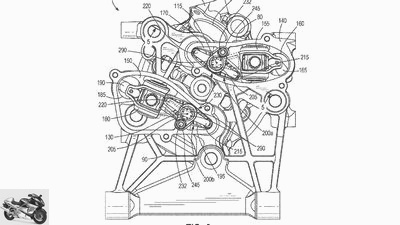
Harley-Davidson
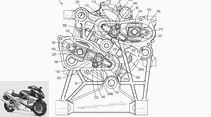
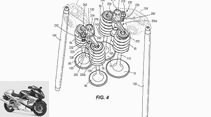
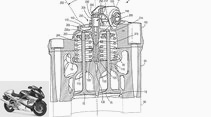
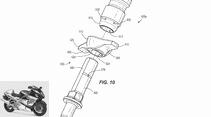
5 photos
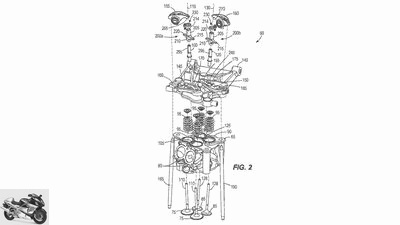
Harley-Davidson
1/5
Harley-Davidson has patented a new valve train for the upcoming air-cooled V2.
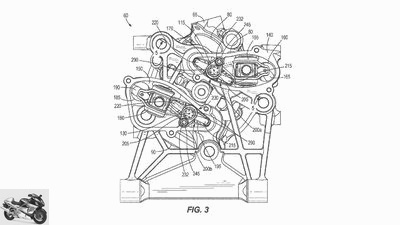
Harley-Davidson
2/5
There will only be simple rocker arms, but valve bridges.
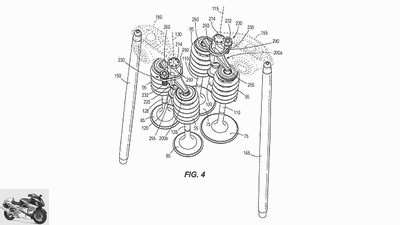
Harley-Davidson
3/5
It remains with pushrods, which then sit on both sides of the cylinder.
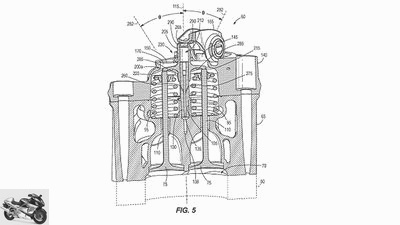
Harley-Davidson
4/5
The valve bridges, controlled by the rocker arm, operate both inlet and outlet valves simultaneously.
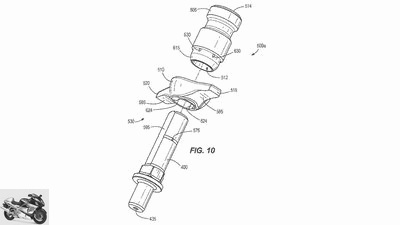
Harley-Davidson
5/5
Valve bridge construction in detail.
Harley-Davidson Pushrod patent
More speed for the next V2
Harley-Davidson is working on the successor to the Milwaukee Eight. It is air-cooled again, but should be able to withstand significantly more speeds, as a now published patent shows.
HAs a traditional manufacturer, arley-Davidson will hold on to air-cooled V2 as long as possible, even if the Americans already have liquid-cooled DOHC units in the making. A successor to the current Milwaukee Eight is therefore already in development. A now published patent reveals the first details about the revised valve train in the new V2.
Valve bridge and more speed
The new engine also uses an OHV arrangement, four-valve technology and push rods. On the new engine, however, they are no longer both on one engine side, but are distributed on both sides of the cylinder. This means that fork rocker arms are no longer controlled, but only a single rocker arm on the inlet and outlet side. This in turn presses on a valve bridge, which then actuates both valves on the inlet and outlet side. The valve bridges are guided and secured against rotation on a central axis. This construction is not new and is also not considered to be very speed-resistant – with around 4,000 tours, valve actuations such as those found predominantly in truck and boat engines have so far reached the limit. Harley-Davidson, on the other hand, claims to be able to achieve 6,800 to 7,000 rpm. The current Milwaukee Eight currently has 5,500 tours. In the largest expansion stage with a displacement of 1.9 liters, 109 hp and 166 Nm of maximum torque are available.
And why the effort? Due to the smaller rocker arms, these can be stiffer and lighter, which in turn means less moving mass. In addition, tilting moments on the valve stems can presumably be reduced by the valve bridges. The patent specification itself also shows that easier maintenance is an advantage.
Unfortunately, the patent specification does not reveal any more about the new engine.
Conclusion
The fact that Harley-Davidson wants to stick to air-cooled engines is understandable given the conservative clientele. The fact that the Americans are betting on higher speeds is very surprising.
Related articles
-
Artistic comparison test naked bikes: BMW R 1150 R Harley-Davidson Dyna Super Glide Sport Triumph Speed Triple Yamaha XJR 1300 Cool and the gang Vier …
-
Harley-Davidson patent: technology for self-balancing
Harley-Davidson. New patent application from Harley-Davidson technology for self-balancing A new patent application from Harley-Davidson …
-
Top test: Harley-Davidson Electra Glide Ultra Limited
Gargolov 24 pictures Gargolov 1/24 The 2014 E-Glide has become a beauty. Gargolov 2/24 The air / water-cooled …
-
Harley-Davidson Electra – Street Glide – Brands, Myths and Engines
Gargolov Comparison test: Harley-Davidson Electra / Street Glide Brands, Myths and Engines Pounding V2 bumper engines, heavy metal, archaic technology: a…
-
Comparison test: Harley-Davidson Softail Rocker C and Victory Jackpot
fact comparison test Cruiser, Harley-Davidson Rocker C, Victory Vegas Harley-Davidson Softail Rocker C and Victory Jackpot First of all: The Victory …
-
Comparison test of speed bikes
fact 65 pictures BMW 1/65 driving report in MOTORRAD 16/2004: the new K 1200 S. BMW 2/65 driving report in MOTORRAD 16/2004: the new K 1200 S. BMW 3/65 …
-
Triumph Speed Triple and KTM Super Duke in comparison
fact 17 pictures fact 1/17 Both bikes are full of power and emotions and can really sweep the rider away, but which one can impress more, the …
-
Driving report Harley-Davidson VRSCA V-Rod
Driving report Harley-Davidson VRSCA V-Rod Down, wild The part has a V-Twin, it says Harley-Davidson very small. Oh friends ?? 115 hp, the boulevard…
-
Harley-Davidson FXLRS Low Rider S.
Motorcycle fair in Milan EICMA 2019 Presented by Harley-Davidson 15th photos Harley-Davidson 1/15 Harley has reissued the Low Rider S. Even more: it…
-
Harley-Davidson Fat Bob put to the test
Harley-Davidson Fat Bob put to the test The dynamic promise Harley says the performance of the new Fat Bob would take your breath away. The…